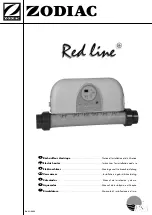
Small particle
Iron
Hardness: most
important ions,
manganese (Mn) and
lime (Calsium) (Ca)
Chrlorinated water
Sea water (salty)
WATER PROPERTIES
EFFECTS
RECOMMENDATION
Color, taste, deposits
Color, smell, taste, deposits
Deposits
Health risk
Fast corrosion
<12 mg/l
<0,2 mg/l
Mn: <0,05 mg/l
Ca: <100 mg/l
Not allowed to use
Not allowed to use
HEATING OF THE SAUNA ROOM
CAUTION!
Smoke and odor formation when heating up for the first time. Work materials from the
manufacturing process will be present on the new heating elements. These evaporate
when the sauna heater is heated up for the first time. This produces smoke and an
unpleasant odor. Breathing in the fumes or smoke can be harmful to your health.
Perform the following steps when operating the sauna heater for the first time and if the
heating elements for the sauna heater have been changed. In this way you will prevent
damage to health due to the fumes and smoke produced when heating up for the first
time.
1.
Select the highest possible temperature in the sauna control.
2.
Heat up the sauna heater for half an hour. Do NOT stay in the sauna cabin during this
period.
3.
Allow the sauna cabin to ventilate thoroughly after heating up for the first time.
4.
If no smoke or odor is produced the next time the sauna heater is heated up, you
can start to use the sauna. If smoke or odor is produced again, leave the sauna cabin
immediately and repeat the initial heating up process followed by ventilation.
Always check the sauna room before switching sauna heater on (to be sure that there is
no combustible things within
the safety distances of the heater or on the heater
).
Make sure that sauna room has been efficiently ventilated. If the output of the heater
is proper it will take about an hour to reach suitable temperature (See page 30). The
temperature in sauna room should be b60 - +90 °C. Temperature is individual in
every sauna room depending on e.g. heater model, size of heater room, air ventilation and
bathers preference. Too powerful heater will heat sauna room too quickly and the stones
won’t have enough time to warm. The water poured on the stones will not evaporate, but
flow into the stone holder. An underpowered heater, on the other hand, would lead to an
undesirably long heating period.
QUALITY REQUIREMENTS FOR WATER WHICH IS
THROWN TO THE HEATER
SUOMI | ENGLISH
25
ENGLISH
25









































